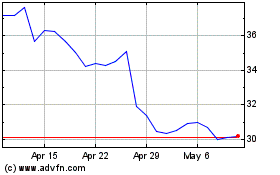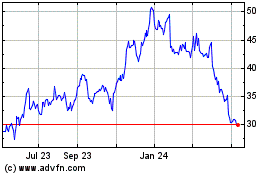New Intel-Created System Offers Professor Stephen Hawking Ability to Better Communicate with the World
December 02 2014 - 11:42AM
Business Wire
Intel Provides Researchers with Open Access
to New Platform to Address 3 Million People Afflicted with Motor
Neuron Diseases, Quadriplegia
NEWS HIGHLIGHTS
- Replacing Professor Hawking’s
decades-old communications system, he can better communicate, has
increased ease of use for his daily routine, empowered with
continued independence
- By January 2015, Intel will provide
customizable solution to researchers and technologists
- The Intel-created advanced
communications platform can be adapted for 3 million people
afflicted with motor neuron diseases and quadriplegia
Today Intel demonstrated for the first time with Professor
Stephen Hawking a new Intel-created communications platform to
replace his decades-old system, dramatically improving his ability
to communicate with the world. The customizable platform will be
available to research and technology communities by January of next
year.
By studying the acute needs of Hawking, and the very specific
relationship between this man and his machine, Intel has delivered
a tailored solution – called ACAT (Assistive Context Aware Toolkit)
– that results in improved communication for Hawking with the
world. It has the potential to become the backbone of a modern,
customizable system other researchers and technologists can use to
benefit those who have motor neuron diseases (MND) and
quadriplegia.
Hawking has an MND related to amyotrophic lateral
sclerosis (ALS), a condition that has progressed over the
years. He is almost entirely paralyzed and communicates through
technology.
“Medicine has not been able to cure me, so I rely on technology
to help me communicate and live,” said Hawking. “Intel has been
supporting me for almost 20 years, allowing me to do what I love
every day. The development of this system has the potential to
improve the lives of disabled people around the world and is
leading the way in terms of human interaction and the ability to
overcome communication boundaries that once stood in the way.”
Increased Speed, Accuracy and Ease of Use
A multidisciplinary team of researchers from Intel Labs has been
working for three years with Hawking to replace his current
communications system with modern technology. Hawking was
instrumental in the design process, providing ongoing feedback, to
help Intel improve the system with every iteration.
“Professor Hawking uniquely used technology to master
communicating with the world for decades, but his old system could
be likened to trying to use today’s modern apps and websites with a
computer without a keyboard or mouse,” said Wen-Hann Wang, Intel
vice president and Intel Labs managing director. “Together we’ve
delivered a holistically better communication experience that
contributes to his continued independence and can help open the
door to increased independence for others.”
Similar to the parts of an engine interacting smoothly to run a
car, the Intel-created software user interface enables existing and
new technologies to efficiently work with each other. The result:
Hawking’s typing speed is twice as fast, and there is a 10x
improvement in common tasks, such as easier, more accurate and
faster browsing, editing, managing and navigating the Web, emails
and documents; opening a new document; and saving, editing and
switching between tasks.
His existing cheek sensor is detected by an infrared switch
mounted to his glasses and helps him select a character on the
computer. Integrating software from British language technology
company SwiftKey* has greatly improved the system’s ability to
learn from Hawking to predict his next characters and words so he
only has to type less than 20 percent of all characters.
This information is sent to his existing speech synthesizer so
he can communicate to others through his Lenovo* laptop running
Microsoft Windows*. For example, to conduct a Web search, Hawking
previously had to take arduous routes, such as exiting from his
communication window, navigating a mouse to run the browser,
navigating the mouse again to the search bar, and finally typing
the search text. The new system automates all of these steps for a
seamless and swift process.
Open, Customizable Software
Quadriplegia and MND affect over 3 million people worldwide. MND
impacts voluntary muscle activities, like speaking, walking,
swallowing and general movement of the body. Progressive in nature,
it causes increasing disability and eventually death.
Lama Nachman of Intel Labs joined Hawking onstage in London to
outline how their work together can inspire the research community.
“Technology for the disabled is often a proving ground for the
technology of the future,” said Nachman. “From communications to
genetic research, technology is beginning to open doors to
possibilities that can only be imagined.”
The new toolkit created by Intel can be customized and changed
to suit different users. The Intel-created system is a modern
software interface for researchers and technologists to create
customized solutions enabled by touch, eye blinks, eyebrow
movements or other user inputs for communication.
With the platform being accessible and free, Intel and Hawking
envision that research and technology communities – such as those
focused on sensing, text prediction, context awareness and user
interface design – will build upon and bring new and improved
solutions to market.
About Intel
Intel (NASDAQ:INTC) is a world leader in computing innovation.
The company designs and builds the essential technologies that
serve as the foundation for the world’s computing devices. As
a leader in corporate responsibility and sustainability, Intel also
manufactures the world’s first commercially available
“conflict-free” microprocessors. Additional information about Intel
is available at newsroom.intel.com and blogs.intel.com, and about
Intel’s conflict-free efforts at conflictfree.intel.com.
Intel and the Intel logo are trademarks of Intel Corporation in
the United States and other countries.*Other names and brands may
be claimed as the property of others.
Intel CorporationAlison Wesley, 408-765-0607Intel PR
Manageralison.wesley@intel.comorPerveen AkhtarIntel U.K. PR
Managerperveen.akhtar@intel.com
Intel (NASDAQ:INTC)
Historical Stock Chart
From Mar 2024 to Apr 2024

Intel (NASDAQ:INTC)
Historical Stock Chart
From Apr 2023 to Apr 2024
